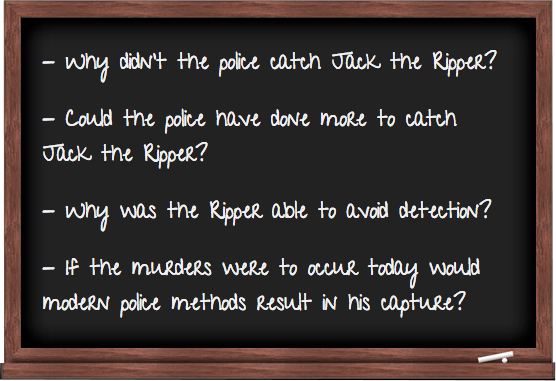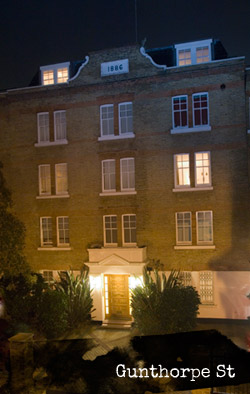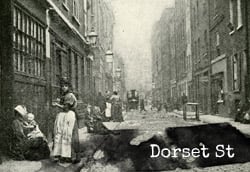A Tour Designed For History Coursework Assignments
Since 2003 we have been conducting a special Jack the Ripper Tour designed to complement the History Coursework for students. This tour specifically focuses on the historic environment of Whitechapel in 1888; looking at the backcloth, such as the social conditions, against which the ripper saga unfolded; details the Police investigation into the murders, and answers a variety of questions pertaining to the crimes:-

SCHOOL TOUR DETAILS
The tour begins at Aldgate East Underground Station and takes pupils straight into Gunthorpe Street, which in 1888 was known as George Yard.

Immediately on the left is a building that shows the date 1886. At the time of the Ripper murders this was a shelter for homeless girls and was run by Sir George Holland.
We discuss a newspaper report at the height of the murders that talks of the girls here being afraid to come home to this dark location after dark for fear of the Ripper.
This introduces pupils to what the area was like in 1888 when it was made up of lots of similar dark thoroughfares. The fact that so much of the area was unlit at night was, of course, one of the main reasons why the murderer was able to go about his business with apparent impunity.
THE SOCIAL CONDITIONS
It also provides the ideal location at which to introduce the social conditions in the 19th century East End of London where a whole underclass of dispossessed citizenry had been all but abandoned by the authorities of the time. Pupils can discuss how this impacted on society as a whole and will be encouraged to put forward their own views on how the Jack the Ripper murders brought the conditions in the area to wider public knowledge and, in so doing, ushered in change.
THE FIRST WHITECHAPEL MURDER
We then discuss the murder of Mary Nichols and explain a little about life in the Common Lodging Houses of the time. Each of Jack the Ripper’s victims came from the area of the common lodging houses and these “dens of iniquity” were another integral part of the reason why Jack the Ripper was able to evade capture.
Moving to the top of George yard we stop at the site of George yard Buildings where Martha Tabram was murdered in early August 1888. We explain why some experts think that she may have been Jack the Ripper’s first victim.
We explain about the murder of Emma Smith at Easter 1888 and discuss how the fact that she survived the initial attack and was able to tell a doctor that she had been attacked by a gang would influence the early days of the Jack the Ripper investigation. We then introduce the Police who investigated the case and talk a little about police methods.
Pupil’s are encouraged to ask questions, proffer their own theories and are able to discuss details of the case with their guide.
THE FIRST JACK THE RIPPER MURDER
We then move to Thrawl Street, where Mary Nichols was lodging at the time of her murder. Here we discuss possible witness sightings of the killer and go in to more detail about the warren like complexity of the Whitechapel Streets that aided the Ripper’s escape. We are able to provide a context for Inspector Moore’s comment to and American journalist that the prostitutes themselves were helping the killer to commit their murders and then get clean away with it. We ask the pupil’s to think on that comment and then ask them to answer how the victims themselves could have assisted their killer to evade detection.

THE STREETS WHERE THE SAGA WAS PLAYED OUT
From this point on we enter Fournier and Wilke’s Streets, both of which are lined with houses that are just as they were in 1888. We discuss an early suspect by the name of “Leather Apron” who, so the prostitutes told police, was running an extortion racket amongst them. We point out how the press emphasising this suspects Hebrew appearance almost sparked off race riots in the East End and explain how when this happened the police began playing down any suggestion that the killer was from the Jewish immigrant community (this is the real reason why Sir Charles Warren the Metropolitan Police Commissioner later ordered the erasure of the chalked message found in a Goulston Street doorway in the wake of Catherine Eddowes’ murder).
PUPILS ARE ENCOURAGED TO DISCUSS
Again pupils are encouraged to ask questions and discuss the facts.
It is at this point we pose the question would Jack the Ripper be caught if he were committing his murders today. This is an intriguing discussion since many pupils at this point say that he would be, since we could use DNA profiling and fingerprinting.
However, as we explain to the pupil’s, to catch someone through their fingerprints or DNA you must first have a record of their fingerprints and DNA, so there is in fact a good chance that he wouldn’t be caught today. This enables us to quote from the report sent to the Home Office by Dr Robert Anderson (the Assistant Commissioner and head of the C.I.D.) in which he says that the reason the killer was so difficult to catch was that he left no clues at the scenes of his crimes.<./p>
COULD THE POLICE HAVE DONE MORE?
Effectively therefore, there was very little that the police could do, other than flood the streets with officers and hope that the next time the killer struck there would be a police man on hand to apprehend him.

ANNIE CHAPMAN AND MARY KELLY
Having visited the site of Annie Chapman’s murder, we pass the Ten Bells and Christchurch Spitalfields, to enter the former Dorset Street where Mary Kelly, the last victim of Jack the Ripper was murdered in Miller’s Court.
THE INFAMOUS JUWES MESSAGE
From here we continue to Goulston Street to visit the doorway where the scrawled chalk message “The Juwes are the men that will not be blamed for nothing” was discovered.
We explain the reservations of the Metropolitan Police that if they waited till it got light to photograph it then the graffito could be seen by thousands of gentile buyers who at 6am would start arriving in the area to purchase from largely Jewish stallholders.
This, they thought, might lead to a resurgence of the anti-Semitism that had come about as a result of the previous Leather Apron scare. This was the reason why Sir Charles Warren ordered its erasure in what was one of his most controversial orders in the entire investigation.
We then discuss the real clue that was found in the doorway, the bloodstained section of Catherine Eddowes apron and get the pupil’s to discuss its significance.
THE MURDER OF CATHERINE EDDOWES
Finally, we move on to Mitre Square to discuss the murder of Catherine Eddowes. It is at this point that we ask the pupil’s to consider all the information and then pose the questions – why didn’t the police catch Jack the Ripper, and could the police have done more to catch him. There follows a final question and answer session and we then lead the group back to Aldgate High Street where the coaches can be waiting to pick up the pupils.
